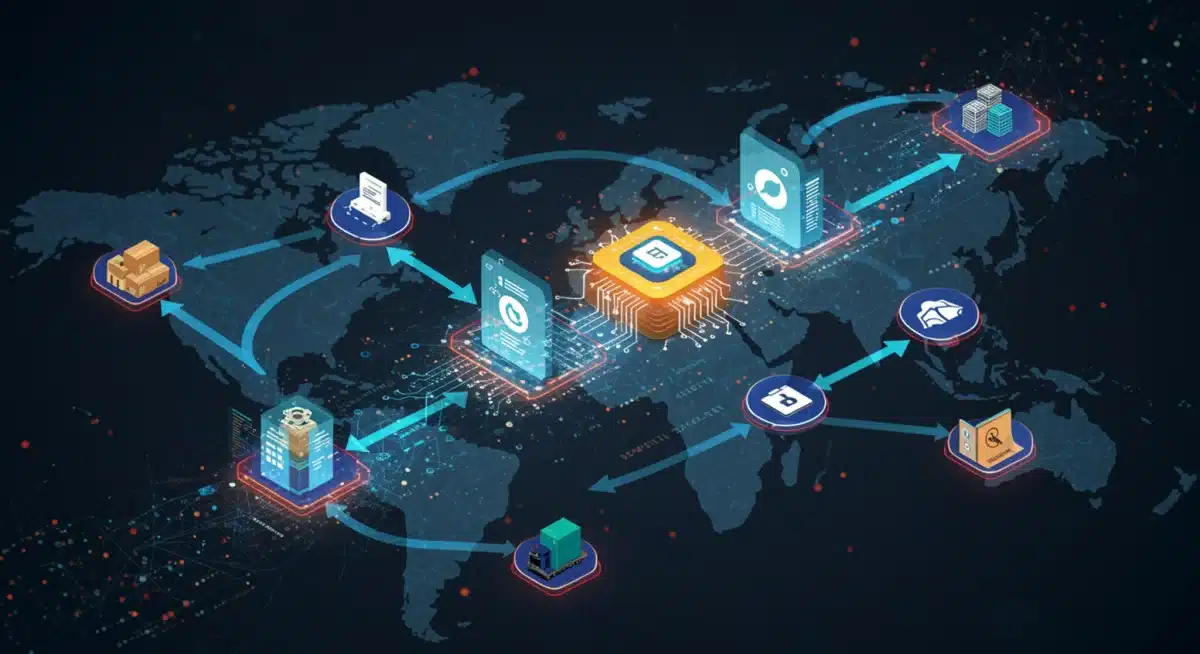Blockchain Beyond Crypto: US Supply Chain Innovation

Blockchain technology is revolutionizing the US supply chain and logistics, offering unprecedented transparency, security, and efficiency beyond its cryptocurrency origins. Its innovative applications streamline operations from source to consumer.
The landscape of global commerce is undergoing a profound transformation, driven by technological advancements that redefine how goods move from production to consumption. Among these innovations, Blockchain Supply Chain US applications are emerging as a game-changer, extending far beyond their origins in cryptocurrency. This distributed ledger technology promises to inject unparalleled transparency, security, and efficiency into the intricate web of American logistics, addressing long-standing challenges and paving the way for a more resilient and accountable future.
The Genesis of Blockchain in Supply Chain: A New Paradigm
The traditional supply chain, often characterized by fragmented data, manual processes, and opaque transactions, has long struggled with issues of trust and traceability. The inherent design of blockchain, a decentralized and immutable ledger, offers a compelling solution to these vulnerabilities. Its foundational principles—decentralization, transparency, and cryptography—are perfectly suited to address the complexities of modern logistics, particularly within the vast and diverse US market.
Initially recognized for powering cryptocurrencies like Bitcoin, blockchain’s true potential lies in its ability to create a tamper-proof record of transactions and events. In the context of supply chains, this translates to an unalterable history of a product’s journey, from its raw materials to the end consumer. This capability is not just about tracking; it’s about building an ecosystem of trust among disparate parties who may not inherently trust each other, yet must collaborate seamlessly.
Understanding Distributed Ledger Technology
At its core, blockchain is a type of Distributed Ledger Technology (DLT). Instead of a single, centralized database, a DLT maintains a shared, synchronized, and immutable record of data across multiple participants. Each participant holds a copy of the ledger, and any new transaction must be validated by the network before being added as a new ‘block’ to the chain. This distributed nature eliminates single points of failure and enhances data integrity.
- Decentralization: No single entity controls the entire network, reducing the risk of manipulation.
- Immutability: Once a transaction is recorded, it cannot be altered or deleted, ensuring a permanent audit trail.
- Transparency: All authorized participants can view transactions, fostering trust and accountability.
- Security: Cryptographic hashing links blocks, making it nearly impossible to tamper with past records.
The application of these principles in the US supply chain promises to transform everything from food safety to pharmaceutical distribution. By providing a single source of truth, blockchain can significantly reduce disputes, improve compliance, and enhance operational efficiency, moving beyond theoretical discussions to tangible, real-world impact across various industries.
Enhancing Transparency and Traceability in US Logistics
One of the most immediate and impactful benefits of blockchain in the US supply chain is the profound enhancement of transparency and traceability. Consumers, regulators, and businesses alike are demanding greater visibility into the origins, journey, and authenticity of products. Blockchain provides an unassailable record for every step, illuminating previously opaque corners of the supply chain.
Consider the journey of a food product from farm to table. In a traditional system, tracking its path can be a laborious, fragmented process, often relying on paper records or disparate digital systems. When a recall becomes necessary, identifying the source of contamination can take days or even weeks, leading to widespread product removal and significant financial losses. Blockchain streamlines this process, allowing for instantaneous pinpointing of affected batches and their precise origins.
Real-time Tracking and Data Integrity
With blockchain, each movement of a product—from harvesting, processing, packaging, shipping, to retail—can be recorded as a transaction on the distributed ledger. This creates a comprehensive, real-time digital footprint. Sensors can automatically log temperature, humidity, and location data, which are then immutably stored on the blockchain. This level of detail is invaluable for perishable goods, high-value items, and products with strict regulatory requirements.
- Food Safety: Rapid identification of contaminated products, minimizing recalls and public health risks.
- Pharmaceuticals: Preventing counterfeit drugs by verifying authenticity at every stage.
- Luxury Goods: Proving provenance and combating fraud by tracking items from creation to sale.
- Conflict Minerals: Ensuring ethical sourcing by tracing materials back to their origin mines.
This enhanced visibility not only benefits consumers but also empowers businesses. Companies can gain deeper insights into their operations, identify bottlenecks, and optimize routing. Regulators can enforce compliance more effectively, and suppliers can build stronger reputations based on verifiable claims of quality and ethical practices. The US market, with its complex regulatory environment and consumer demands, stands to gain immensely from this level of transparency.
Streamlining Operations with Smart Contracts
Beyond simply tracking assets, blockchain’s ability to execute self-enforcing agreements through smart contracts is a transformative feature for US supply chain and logistics. Smart contracts are essentially digital contracts stored on a blockchain that automatically execute when predetermined conditions are met. This eliminates the need for intermediaries, reduces administrative overhead, and accelerates transaction processes.
Imagine a scenario where a payment to a freight carrier is automatically released once GPS data confirms the goods have been delivered to the agreed-upon location and quality control sensors verify the product’s condition. This automation removes delays, reduces human error, and ensures that all parties adhere to the terms of their agreements without constant oversight. The implications for efficiency and cost savings are immense.

Applications of Smart Contracts in Logistics
Smart contracts can automate a wide array of supply chain processes, from inventory management to customs clearance. By digitizing and automating contractual obligations, businesses can achieve new levels of operational fluidity and predictability. This is particularly relevant in the US, where diverse regulations and numerous stakeholders can often complicate cross-state and international logistics.
- Automated Payments: Releasing payments upon delivery or completion of service, reducing payment cycles.
- Compliance Checks: Automatically verifying that goods meet regulatory standards before shipment.
- Inventory Management: Triggering reorders when stock levels fall below a certain threshold.
- Claims Processing: Automating insurance claims based on verifiable event data, such as damage during transit.
The integration of smart contracts transforms theoretical agreements into actionable, self-executing protocols. This not only enhances trust between trading partners but also frees up valuable human resources from tedious administrative tasks, allowing them to focus on strategic initiatives. For the dynamic US supply chain, this represents a significant leap forward in operational excellence and risk mitigation.
Combating Fraud and Enhancing Security
Fraud, theft, and counterfeiting represent significant challenges and financial losses across global supply chains, including within the United States. Blockchain’s cryptographic security features and immutable ledger provide a robust defense against these illicit activities. By creating a verifiable and tamper-proof record of every transaction, blockchain makes it exceedingly difficult for malicious actors to introduce counterfeit goods or manipulate data.
The inherent security of blockchain stems from its decentralized nature and cryptographic hashing. Each block of transactions is linked to the previous one using a cryptographic hash, meaning any attempt to alter a past transaction would invalidate all subsequent blocks. This makes retrospective data manipulation virtually impossible without consensus from the entire network, a formidable barrier to fraud.
Protecting High-Value and Sensitive Goods
For industries dealing with high-value goods, sensitive materials, or intellectual property, blockchain offers an unprecedented level of protection. From luxury items and electronics to pharmaceuticals and defense components, ensuring the authenticity and integrity of products is paramount. The US economy, with its significant production and consumption of such goods, stands to benefit greatly from this enhanced security.
- Counterfeit Prevention: Verifying product authenticity from manufacturing to sale, particularly for pharmaceuticals and designer goods.
- Data Integrity: Protecting sensitive logistics data from unauthorized access or alteration.
- Theft Reduction: Making it harder to introduce stolen goods into legitimate supply chains by lacking verifiable blockchain records.
- Intellectual Property: Securing design specifications and proprietary information throughout the production process.
By providing an unalterable audit trail and a verifiable source of truth, blockchain technology instills confidence among consumers and businesses. It acts as a digital guardian, safeguarding the integrity of products and data, thereby reducing financial losses associated with fraud and protecting brand reputation in the competitive US market.
Optimizing Inventory Management and Waste Reduction
Inefficient inventory management is a perennial problem for many businesses, leading to either costly overstocking or detrimental understocking. Both scenarios result in significant financial losses and contribute to waste. Blockchain technology offers a pathway to optimize inventory levels, improve forecasting, and ultimately reduce waste across the US supply chain.
By providing real-time, accurate, and shared data on product movement and stock levels, blockchain enables a more precise and collaborative approach to inventory. Every item can be tracked individually, offering granular insights into its location, condition, and demand. This data, accessible to all authorized parties—from manufacturers to retailers—allows for better coordination and more informed decision-making.
Precision and Efficiency in Stock Management
The ability to track individual units and their attributes on a blockchain creates a ‘digital twin’ of the physical inventory. This digital record can include manufacturing dates, expiration dates, batch numbers, and even environmental conditions during transit. Such detailed information is crucial for perishable goods or products with strict shelf-life requirements, helping to minimize spoilage and obsolescence.
- Reduced Spoilage: Better management of perishable goods through precise tracking and dynamic routing.
- Optimized Stock Levels: Accurate, real-time data allows for demand-driven inventory, reducing warehousing costs.
- Waste Reduction: Minimizing expired products or those damaged due to improper handling, leading to a more sustainable supply chain.
- Faster Recall Management: Quickly identifying and isolating affected products, reducing the scope of recalls and associated waste.
For the vast and complex US supply chain, where goods traverse diverse climates and regulatory zones, optimizing inventory through blockchain can lead to substantial cost savings and a reduced environmental footprint. This precision in stock management not only benefits the bottom line but also contributes to greater sustainability and resource efficiency.
![]()
Challenges and Future Outlook for Blockchain Adoption in the US
While the benefits of blockchain in the US supply chain are compelling, its widespread adoption is not without challenges. Implementing a new foundational technology requires significant investment, overcoming legacy systems, and fostering collaboration across diverse stakeholders. The journey from pilot projects to full-scale integration is complex, demanding strategic planning and a clear understanding of the regulatory landscape.
One of the primary hurdles is interoperability. Many companies already utilize various digital systems, and integrating blockchain with these existing platforms can be technically challenging. Furthermore, establishing industry-wide standards and protocols for blockchain implementation is crucial to ensure seamless data exchange and network compatibility. Without common standards, the true network effect of blockchain cannot be fully realized.
Overcoming Adoption Barriers
Education and awareness also play a significant role. Many businesses, particularly small and medium-sized enterprises (SMEs), may lack the technical expertise or financial resources to invest in blockchain solutions. Demonstrating clear return on investment (ROI) and providing accessible implementation pathways will be vital for broader adoption. Moreover, regulatory clarity regarding data privacy, ownership, and cross-border transactions is essential to build confidence and mitigate legal risks.
- Interoperability: Integrating blockchain with existing enterprise resource planning (ERP) and logistics systems.
- Standardization: Developing common protocols and data formats across different industries.
- Scalability: Ensuring blockchain networks can handle the immense volume of transactions in large supply chains.
- Regulatory Clarity: Addressing legal frameworks for data governance, smart contracts, and digital identities.
Despite these challenges, the future outlook for blockchain in the US supply chain is optimistic. As technology matures and successful case studies proliferate, the barriers to entry will likely diminish. Government initiatives, industry consortia, and technological advancements are continually working to address these issues, paving the way for blockchain to become a standard component of resilient, efficient, and transparent supply chains across the nation.
The Role of Blockchain in Building Resilient Supply Chains
Recent global events have underscored the critical need for resilient supply chains capable of withstanding disruptions, whether from natural disasters, geopolitical tensions, or pandemics. The traditional, linear model of supply chains often lacks the agility and transparency required to adapt quickly to unforeseen circumstances. Blockchain technology offers a powerful toolkit for building more robust and adaptable supply chain ecosystems in the US.
By providing a single, shared source of truth, blockchain enhances visibility across the entire network. This means that when a disruption occurs, all authorized parties can quickly access accurate information about affected shipments, alternative routes, and available inventory. This real-time data empowers businesses to make informed decisions rapidly, minimizing delays and mitigating the financial impact of disruptions.
Enhancing Adaptability and Risk Management
The immutability of blockchain records also supports stronger risk management. Companies can audit their supply chain history with complete confidence, identifying vulnerabilities and implementing preventative measures. Smart contracts can be programmed to automatically trigger contingency plans, such as rerouting shipments or engaging alternative suppliers, when specific conditions are not met. This proactive approach significantly reduces reliance on manual interventions during crises.
- Disruption Management: Faster identification of affected areas and resources, enabling quick response.
- Contingency Planning: Automated execution of backup plans through smart contracts.
- Supplier Vetting: Verifiable records of supplier performance and compliance, aiding in selecting resilient partners.
- Geopolitical Risk: Tracking goods through complex international routes with enhanced security and transparency.
The ability to create a secure, transparent, and automated network makes blockchain an invaluable asset for reinforcing supply chain resilience. In a world increasingly prone to unpredictable events, the US supply chain can leverage this technology to not only recover faster from disruptions but also to anticipate and prevent them, ensuring continuity and stability for businesses and consumers alike.
| Key Application | Benefit in US Supply Chain |
|---|---|
| Enhanced Traceability | Provides end-to-end visibility, combating counterfeits and improving food safety recalls. |
| Smart Contracts | Automates payments and compliance, reducing intermediaries and accelerating transactions. |
| Fraud Prevention | Secures data and product authenticity with immutable records, reducing financial losses. |
| Inventory Optimization | Enables real-time tracking and precise forecasting, minimizing waste and costs. |
Frequently Asked Questions About Blockchain in Supply Chain
▼
Blockchain’s primary benefit is providing unprecedented transparency and traceability. It creates an immutable, shared record of every product movement and transaction, allowing all authorized parties to track goods from origin to consumer, significantly reducing fraud and enhancing accountability.
▼
Smart contracts automate critical logistics processes. They are self-executing agreements that trigger actions, like payments or reorders, when predefined conditions are met. This automation reduces manual intervention, speeds up transactions, and minimizes errors, leading to greater efficiency and cost savings.
▼
Yes, blockchain significantly combats counterfeiting. By creating a tamper-proof digital history of a product, from manufacturing to sale, it allows for instant verification of authenticity. Any attempt to introduce fake goods would lack the verifiable blockchain record, making it easier to detect fraud.
▼
Key challenges include integrating blockchain with existing legacy systems, establishing industry-wide standards for interoperability, scalability issues, and navigating a complex regulatory landscape. Overcoming these requires significant investment, collaboration, and clear policy guidance.
▼
Blockchain enhances resilience by providing real-time, shared data across the network, enabling quicker responses to disruptions. Its immutable records support better risk management and allow for automated contingency plans via smart contracts, ensuring greater adaptability and continuity during crises.
Conclusion
The journey of blockchain from a niche technology powering cryptocurrencies to a foundational innovation for the US supply chain and logistics sector is a testament to its transformative power. By fostering unparalleled transparency, enabling automated smart contracts, fortifying security against fraud, and optimizing inventory management, blockchain is not merely an incremental improvement but a paradigm shift. While challenges related to integration, standardization, and regulation remain, the long-term benefits of a more resilient, efficient, and trustworthy supply chain are undeniable. As industries continue to explore and implement these innovative applications, blockchain is poised to redefine how goods move across the nation, driving economic growth and setting new benchmarks for operational excellence.





